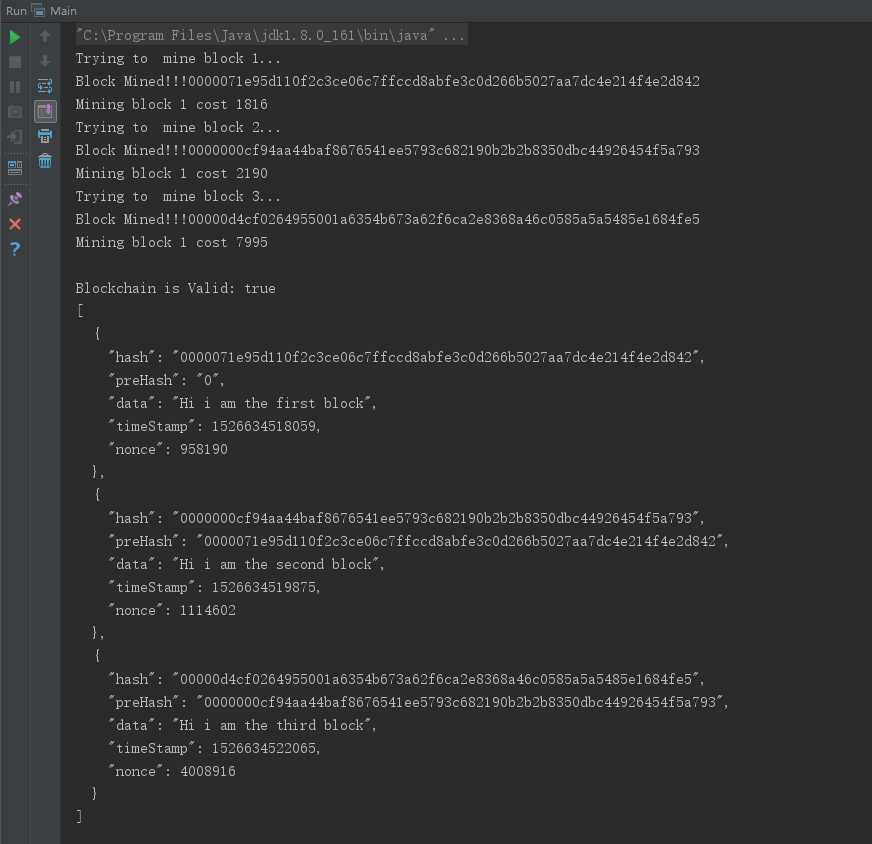用Java编写第一个区块链
Posted vito-yan
tags:
篇首语:本文由小常识网(cha138.com)小编为大家整理,主要介绍了用Java编写第一个区块链相关的知识,希望对你有一定的参考价值。
原文地址:https://www.cnblogs.com/zacky31/p/9057193.html
目标:
- 创建一个最基本的“区块链”
- 实现一个简单的挖矿系统
前提:
对面向对象编程有一定的基础
注意:
值得注意的是,这不会是一个完整的功能,恰恰相反,这是一个概念证明的实例,可以帮助您进一步了解区块链。
准备:
我将会使用Java来实现,当然你也可以使用任何面向对象的语言。
环境:
- JDK 8
- IDEA
- Maven
开始吧
区块链就好比多个块连接起来。其中每一块都将拥有自己的签名,签名中包含其前面的块信息和一些数据(例如交易信息)。

每个块不仅仅包含它之前的块信息,同时也包含自身。如果前面一块内容改变了,其 hash 值也会改变,将会导致其后面所有的块发生变化。通过计算和比较所得的 hash 值,我们可以判断区块链是否合法。换句话说,改变区块链中的任意内容,将会改变整个区块链的签名。
根据上面的分析,我们先创建一个 Block 类。
import java.util.Date; public class Block { public String hash; //存放数字签名 public String preHash; //前面块的签名 private String data; private long timeStamp; public Block(String data, String preHash) { this.data = data; this.preHash = preHash; this.timeStamp = new Date().getTime(); } }
接下来,我们需要一个生成签名的方法。有很多加密算法可供选择,这里使用 SHA256 刚刚好。
import java.security.MessageDigest; public class StringUtil { public static String applySha256(String input) { try { MessageDigest digest = MessageDigest.getInstance("SHA-256"); byte[] hash = digest.digest(input.getBytes("UTF-8")); StringBuilder hexString = new StringBuilder(); for (int i = 0; i < hash.length; i++) { String hex = Integer.toHexString(0xff & hash[i]); if (hex.length() == 1) hexString.append(‘0‘); hexString.append(hex); } return hexString.toString(); } catch (Exception e) { throw new RuntimeException(e); } } }
现在,我们向 Block 类中添加计算数字签名的方法,并修改一下其构造方法。
public Block(String data, String preHash) { this.data = data; this.preHash = preHash; this.timeStamp = new Date().getTime(); this.hash = calculateHash(); } public String calculateHash() { String calculatedhash = StringUtil.applySha256(preHash + Long.toString(timeStamp) + data); return calculatedhash; }
到这里,可以写个 Main 方法看一下效果。
public class Main { public static void main(String[] args) { Block first = new Block("Hi i am the first block", "0"); System.out.println("Hash for block 1 : " + first.hash); Block second = new Block("Hi i am the second block", first.hash); System.out.println("Hash for block 2 : " + second.hash); Block third = new Block("Hi i am the third block", second.hash); System.out.println("Hash for block 3 : " + third.hash); } }

可以看见每个 Block 都有自己唯一的 数字签名,当然,现在还没有构成一个区块链,将这些块存放到一个 ArrayList 中吧。修改 Main 类后再次运行。
import com.google.gson.GsonBuilder; import java.util.ArrayList; public class Main { public static ArrayList<Block> blockchain = new ArrayList<Block>(); public static void main(String[] args) { blockchain.add(new Block("Hi i am the first block", "0")); blockchain.add(new Block("Hi i am the second block", blockchain.get(blockchain.size() - 1).hash)); blockchain.add(new Block("Hi i am the third block", blockchain.get(blockchain.size() - 1).hash)); String blockchainJson = new GsonBuilder().setPrettyPrinting().create().toJson(blockchain); System.out.println(blockchainJson); } }

现在,需要一种方法去验证创建的区块链。编写一段 isChainValid() 方法。任何块的改变将会导致这个方法失效。
public static Boolean isChainValid() { Block currentBlock; Block previousBlock; for (int i = 1; i < blockchain.size(); i++) { currentBlock = blockchain.get(i); previousBlock = blockchain.get(i - 1); if (!currentBlock.hash.equals(currentBlock.calculateHash())) { System.out.println("Current Hashes not equal!"); return false; } if (!previousBlock.hash.equals(currentBlock.preHash)) { System.out.println("Previous Hashes not equal!"); return false } } return true; }
接下来,尝试一下挖矿!

在 Block 类中,新增一个变量 nonce,并且添加到 calculateHash() 这个方法中,同时需要 mineBlock() 这个方法。这个方法中的 difficulty 变量就是用来控制计算量的。当设置的值较低时,大部分计算机很快就能算出来。
import java.util.Date; public class Block { public String hash; public String preHash; private String data; private long timeStamp; private int nonce; public Block(String data, String preHash) { this.data = data; this.preHash = preHash; this.timeStamp = new Date().getTime(); this.hash = calculateHash(); } public String calculateHash() { String calculatedhash = StringUtil.applySha256(preHash + Long.toString(timeStamp) + Integer.toString(nonce) + data); return calculatedhash; } public void mineBlock(int difficulty) { String target = new String(new char[difficulty]).replace(‘�‘, ‘0‘); while (!hash.substring(0, difficulty).equals(target)) { nonce++; hash = calculateHash(); } System.out.println("Block Mined!!!" + hash); } }
我们可以在 Main 类中定义个静态变量。尝试在每次创建新块去调用 mineBlock() 方法。
import com.google.gson.GsonBuilder; import java.util.ArrayList; import java.util.Date; public class Main { public static ArrayList<Block> blockchain = new ArrayList<Block>(); public static int difficulty = 5; public static void main(String[] args) { long beginTime1 = new Date().getTime(); blockchain.add(new Block("Hi i am the first block", "0")); System.out.println("Trying to mine block 1..."); blockchain.get(0).mineBlock(difficulty); long endTime1 = new Date().getTime(); System.out.println("Mining block 1 cost " + (endTime1 - beginTime1)); long beginTime2 = new Date().getTime(); blockchain.add(new Block("Hi i am the second block", blockchain.get(blockchain.size() - 1).hash)); System.out.println("Trying to mine block 2..."); blockchain.get(1).mineBlock(difficulty); long endTime2 = new Date().getTime(); System.out.println("Mining block 1 cost " + (endTime2 - beginTime2)); long beginTime3 = new Date().getTime(); blockchain.add(new Block("Hi i am the third block", blockchain.get(blockchain.size() - 1).hash)); System.out.println("Trying to mine block 3..."); blockchain.get(2).mineBlock(difficulty); long endTime3 = new Date().getTime(); System.out.println("Mining block 1 cost " + (endTime3 - beginTime3)); System.out.println(" Blockchain is Valid: " + isChainValid()); String blockchainJson = new GsonBuilder().setPrettyPrinting().create().toJson(blockchain); System.out.println(blockchainJson); } public static Boolean isChainValid() { Block currentBlock; Block previousBlock; String hashTarget = new String(new char[difficulty]).replace(‘�‘, ‘0‘); for (int i = 1; i < blockchain.size(); i++) { currentBlock = blockchain.get(i); previousBlock = blockchain.get(i - 1); if (!currentBlock.hash.equals(currentBlock.calculateHash())) { System.out.println("Current Hashes not equal!"); return false; } if (!previousBlock.hash.equals(currentBlock.preHash)) { System.out.println("Previous Hashes not equal!"); return false; } if (!currentBlock.hash.substring(0, difficulty).equals(hashTarget)) { System.out.println("This block hasn‘t been mined"); return false; } } return true; } }
运行发现,挖矿过程还是很费时间的。把计算量改成7,差不多每挖一个需要一分钟。。。

如果在此过程中,有人篡改了数据,将会导致:
- 区块链将会无效
- 不能够创建一个更长的区块链
- 网络中的诚实链将会比较长的区块链有时间上的优势
不过如果篡改数据拥有更强的运算速度,可能成功篡改。
这样,基本上简单实现了一个区块链了。
以上是关于用Java编写第一个区块链的主要内容,如果未能解决你的问题,请参考以下文章